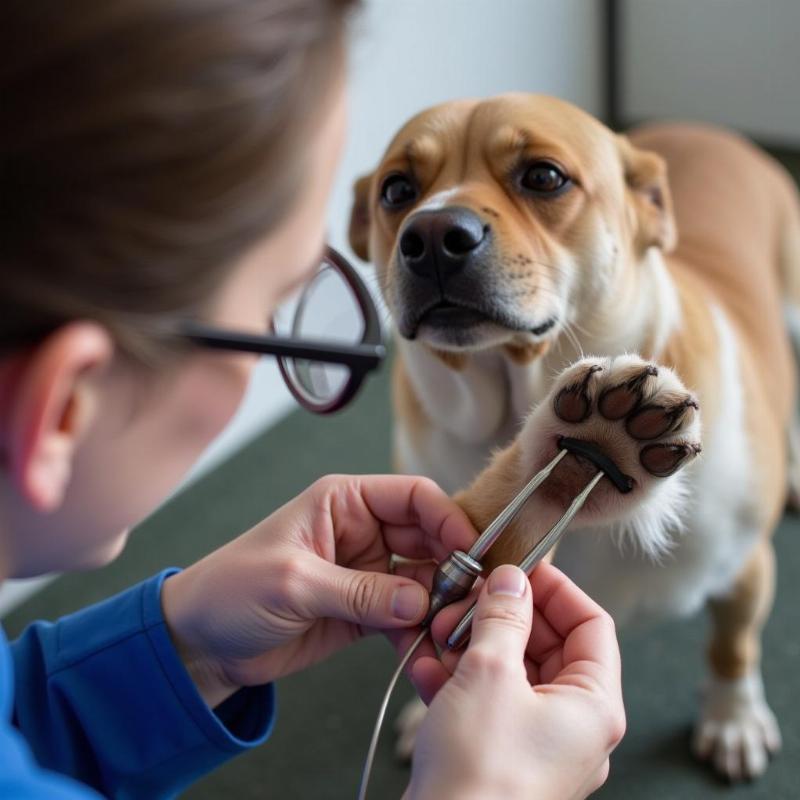Dog grass seed in paw is a common, yet often overlooked problem, especially during the warmer months. These tiny, seemingly harmless seeds can cause significant discomfort and even serious health issues for your furry friend. Understanding the risks, recognizing the signs, and knowing how to prevent and treat grass seed penetration is crucial for every responsible dog owner in the US.
Identifying the Culprit: Types of Grass Seeds and Their Dangers
Several types of grass seeds can pose a threat to your dog, including foxtail, cheatgrass, and needlegrass. These seeds are designed by nature to burrow and attach, making them particularly problematic for dogs. Their sharp, barbed ends can easily penetrate the skin, fur, and even the delicate tissues of your dog’s paws, ears, nose, and eyes. Once embedded, these seeds can migrate further into the body, causing infections, abscesses, and even internal damage.
Why Paws are Particularly Vulnerable
A dog’s paws are constantly in contact with the ground, making them prime targets for grass seeds. The soft pads and the spaces between the toes are especially susceptible to penetration. Regularly checking your dog’s paws after walks, especially in areas with tall grasses, is vital.
Recognizing the Signs: Is Your Dog Suffering from a Grass Seed?
Identifying a grass seed in your dog’s paw early on can prevent more serious complications. Common signs include:
- Excessive licking or biting at the paw
- Limping or favoring one paw
- Swelling, redness, or discharge from the affected area
- Visible seed or entry point
- Pain or discomfort when the paw is touched
If your dog displays any of these signs, consult a veterinarian immediately.
Prevention is Key: Minimizing the Risk of Grass Seed Injuries
Taking proactive steps can significantly reduce the risk of grass seed problems for your dog. Consider these preventative measures:
- Keep your lawn mowed regularly to prevent seed heads from forming.
- Avoid walking your dog in areas with tall, dry grasses, especially during seed-bearing season.
- Consider using dog booties to protect your dog’s paws.
- Brush your dog’s coat regularly to remove any clinging seeds. grass seeds in dogs paws
Choosing Dog-Friendly Grasses
If you’re landscaping your yard, consider opting for dog-friendly grass varieties that are less likely to produce problematic seeds. Consult with a local landscaping professional for recommendations. grass seed and dogs paws
Treatment Options: What to Do if Your Dog Gets a Grass Seed in Their Paw
If you suspect a grass seed is embedded in your dog’s paw, do not attempt to remove it yourself. Seek professional veterinary care. A veterinarian can safely remove the seed and provide appropriate treatment to prevent infection and further complications. best grass seed for ohio with dogs
Veterinary Procedures for Grass Seed Removal
Depending on the location and depth of the embedded seed, your veterinarian may use tweezers, forceps, or even perform a minor surgical procedure to remove it. They may also prescribe antibiotics or pain medication.  Veterinarian removing grass seed from dog's paw
Veterinarian removing grass seed from dog's paw
Conclusion: Keeping Your Dog’s Paws Safe from Grass Seeds
Dog grass seed in paw can be a painful and potentially serious issue. By understanding the risks, recognizing the signs, and taking proactive preventative measures, you can protect your canine companion from the discomfort and potential health complications associated with these pesky seeds. Regular paw checks, especially after walks in grassy areas, are crucial for early detection and prompt treatment. ornamental grasses safe for dogs
FAQ:
- What are the most common types of grass seeds that affect dogs? Foxtail, cheatgrass, and needlegrass are among the most problematic.
- Can I remove a grass seed from my dog’s paw myself? No, it’s best to consult a veterinarian for safe removal and treatment.
- What are the signs of a grass seed in a dog’s paw? Licking, limping, swelling, redness, discharge, and visible seed or entry point.
- How can I prevent grass seeds from getting into my dog’s paws? Mow your lawn regularly, avoid tall grasses, use dog booties, and brush your dog’s coat.
- What should I do if I find a grass seed in my dog’s ear or nose? Seek immediate veterinary attention.
- Are there any dog-friendly grass varieties? Yes, consult a landscaping professional for recommendations.
- How serious can a grass seed injury be? If left untreated, it can lead to infections, abscesses, and even internal damage.
Beautdogs.us is your trusted source for comprehensive dog care information, breed expertise, and product recommendations. We cater to both novice and experienced dog owners, empowering you with the knowledge and resources to provide the best possible care for your furry friend. From understanding the nuances of dog grass seed in paw to finding the best wipes for dogs eyes, Beautdogs.us has you covered. Contact us today for personalized advice and support! Email: [email protected], Phone: +1 501-555-7529.